If someone rolls into my driveway with a 1968 Fairlane Torino, in search of a pickle fork to repair a broken ball joint, I’ve got the situation covered. Fortunately, or unfortunately, my collection of esoteric tools has also carried over to my reloading activities, at least to the point I no longer recognize many of the items residing in my supply cabinet. The cause of the lapse in tool memory isn’t all bad news; as I work to improve the quality of my handloads, the really useful tools stay in front of me all of the time, and the more interesting but useless gadgets get pushed to the background where they are eventually forgotten.
I thought I might create an opportunity to advance the .257 Weatherby Magnum handloading project, and simultaneously step through the routine that’s developed in my own handloading as I’ve gained more practical experience. Recognizing handloading, like religion, is a deeply personal and spiritual experience, please feel free to laugh at, or ignore, any of the following information.
Press Selection – It’s not the price…it’s the value
As a reality, expensive tools rarely result in proportionally better quality output. Most expensive automated and/or progressive tools are designed to spare the reloader from boredom born of production monotony, and not to make better performing ammo. At the height of equipment capability and cost, I’m sure it’s a reasonable expectation that the handloader can: reload ammo, eat a baloney and mustard sandwich and watch reruns of the Soprano’s while creating ammo with most of the right parts, in most of the right places.
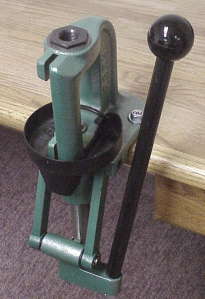 I own several presses, both single stage and progressive. At the left is a picture of the press that yields, for me, the best quality ammo and the best range results. The simple RCBS Rock Chucker super sturdy and easy to use. Available through many Internet discount retailers for about $90, including freight, or about $240 less than a new RCBS Pro2000, or about $1million or so less than anything painted blue.
I own several presses, both single stage and progressive. At the left is a picture of the press that yields, for me, the best quality ammo and the best range results. The simple RCBS Rock Chucker super sturdy and easy to use. Available through many Internet discount retailers for about $90, including freight, or about $240 less than a new RCBS Pro2000, or about $1million or so less than anything painted blue.
The only suggested drawback to a single stage press is that dies must be changed, in proper sequence, until all phases of handloading are complete. A progressive press, supposedly, keeps all dies mounted in a plate, while the cartridges rotate from one station to the next until complete, but without following a proper reloading sequence.
The progressive press typically begins with a combination decap and size, then automatically rotates the case around to a new primer, powder charge and seated bullet. Briefly, you can’t properly clean and inspect a case unless the spent primer has been removed from the primer pocket, so a decap should be immediately followed with clean and inspect. Sizing stretches cases, so sizing should be followed with case measurement, and possibly trim, to insure the case is within overall length spec. You could interrupt the process of a progressive press to accomplish these tasks, but then you would have effectively created a single stage press.
Yes, when using a single stage press, at each operation I have to change the die two or three times per session, depending on the cartridge, but I always have absolute control over the sequence of steps in the reloading process. There is no such control with an automatic progressive press. I can decap, tumble or soak cases, inspect, size, trim, prime, charge and seat a bullet – each step accomplished on the best possible equipment for the job, on or off the press, which is why I currently load all rifle cartridges with a Rock Chucker. This isn’t an ad for RCBS, each major equipment manufacturer offers a very heavy duty H or C type single stage loading press.
Where to begin, where to begin
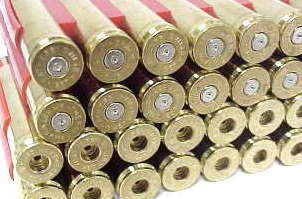 If you’ve missed me saying it before, I’ll say it again, I really like the little Weatherby Ultralight in .257 WM. Over the past weeks, I thought I had made a sufficient number of trips to the range, to generate enough empties for an expansive experimental handloading effort. Not so, I had to supplement my stash with some overpriced Weatherby brass.
If you’ve missed me saying it before, I’ll say it again, I really like the little Weatherby Ultralight in .257 WM. Over the past weeks, I thought I had made a sufficient number of trips to the range, to generate enough empties for an expansive experimental handloading effort. Not so, I had to supplement my stash with some overpriced Weatherby brass.
The handloading process began with a big pile of once fired Weatherby brass, and unprimed new Weatherby brass; the first requiring decapping and cleaning, the second needing cleaning to remove the manufacturing process oil film. I decided I needed to start my loading session by putting all the brass in the same decapped and empty condition for cleaning.
When a primer is fired, this initial pressure backs it out of the case and up against the breech face. Next, the main powder charge rapidly burns, builds pressure, and drives the case back over the spent primer. During the primer/case separation, combusted primer compound works its way onto the face and walls of the primer pocket. If the pocket isn’t cleaned, compound residue may cause the new primer to not seat property or may obstruct the flash hole, and cause a misfire.

Rather than subjecting a decap/sizing dies to a dirty case with grit that might damage the die, or put case lube on a dirty case, I invested in a universal decap die. Unlike a standard combination decap and sizing die, the inside of the decap die is hollowed out, rather than machined to follow the outline of the cartridge. A decap rod extends through the top and runs the full length of the die. The button on the end of the decap rod is less than .021″ and will clear even a .22 centerfire neck without interference.
 This is an easy die to use in the Rock Chucker. Select the correct shell holder for the cartridge. Here I’m using a #4 holder which is correct for any cartridges that is derived from the .375 H&H.
This is an easy die to use in the Rock Chucker. Select the correct shell holder for the cartridge. Here I’m using a #4 holder which is correct for any cartridges that is derived from the .375 H&H.
The die is screwed into the press until it is 1/16″ above the raised ram. The decap pin is adjusted until it protrudes to the flat of the shell holder. The pin should protrude only enough to knock out the primer, but not so far that it deforms the flat or web surface at the bottom of the case. Decapping is a fast operation…..maybe two or three million decaps a minute, if you’re paying attention. No I don’t know what that means but I’m really running behind deadline.
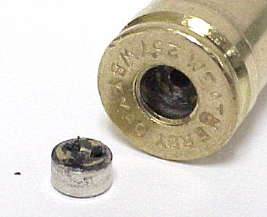 Here’s a closer shot of the spent primer and the gunk left inside the primer pocket. The next step should be case cleaning rather than using a pocket brush on the residue. At this stage the residue is pretty thick, so some preliminary cleaning will make brushing a minimal effort. Typically, tumbling would provide the preliminary cleaning, but tumbling tends to take a long time, the process work hardens the brass, and rounds over rims, case mouths and extractor grooves. In addition, while tumbling medium like walnut or corn husks tend to make the outside of the case look nice and shiny, they don’t do a whole lot for the inside of the case where burnt powder deposits accumulate.
Here’s a closer shot of the spent primer and the gunk left inside the primer pocket. The next step should be case cleaning rather than using a pocket brush on the residue. At this stage the residue is pretty thick, so some preliminary cleaning will make brushing a minimal effort. Typically, tumbling would provide the preliminary cleaning, but tumbling tends to take a long time, the process work hardens the brass, and rounds over rims, case mouths and extractor grooves. In addition, while tumbling medium like walnut or corn husks tend to make the outside of the case look nice and shiny, they don’t do a whole lot for the inside of the case where burnt powder deposits accumulate.
You can never clean cases too much

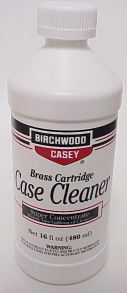 Birchwood Casey Brass Cartridge Case Cleaner is a little different than most liquid cleaners. As an example, this cleaner is not used in conjunction with a waterproof tumbler or drum, so the cash outlay for a cleaning setup is very low. The cleaner is about $8 for 16 oz., and 16 oz. is suppose to clean 8,000 medium size cases – that’s about 1/10 of a cent per case.
Birchwood Casey Brass Cartridge Case Cleaner is a little different than most liquid cleaners. As an example, this cleaner is not used in conjunction with a waterproof tumbler or drum, so the cash outlay for a cleaning setup is very low. The cleaner is about $8 for 16 oz., and 16 oz. is suppose to clean 8,000 medium size cases – that’s about 1/10 of a cent per case.
Case Cleaner isn’t a petroleum based product, but rather an acid wash, consequently it has it’s own set of safety rules that must be followed. I found it was easy to handle, and did not present a problem in normal use. My wife insisted the last label caution precluded my use of the product, but then……she isn’t the boss of me.
The typical mix of this concentrate is 2 oz. per quart of water. I had no problem cleaning 60 cartridges at a time in this much solution. I’m sure a plastic pail of the stuff could be used to clean hundreds of cases at a time, since there is no fuming or unpleasant odors.
 Obviously, I went for the “price is no object” approach for my cleaning containers. Two of these, one for cleaning, one for pouring off the cleaning solution from the brass, set me back almost $3. I picked this type of plastic container because it provided a wide mouth for loading, and the small pop cap for draining. The whole cleaning cycle takes 3 minutes with agitation each minute. The solution never darkened more than the picture to the right; at first I thought the stuff wasn’t working. Wow, my use of punctuation is terrible!
Obviously, I went for the “price is no object” approach for my cleaning containers. Two of these, one for cleaning, one for pouring off the cleaning solution from the brass, set me back almost $3. I picked this type of plastic container because it provided a wide mouth for loading, and the small pop cap for draining. The whole cleaning cycle takes 3 minutes with agitation each minute. The solution never darkened more than the picture to the right; at first I thought the stuff wasn’t working. Wow, my use of punctuation is terrible!
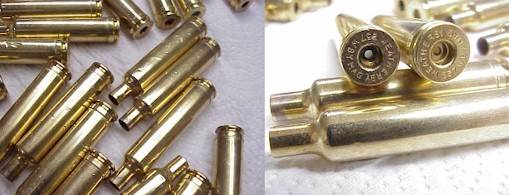
When cleaning was complete, the external surface of the cases were spotless and as polished looking as tumbling would have left them. There were a few cases that still had some minor residue in the primer pockets, but this was minor and certainly less than found with tumbled cases. A quick hit with the pocket brush removed whatever material was left. Big surprise inside the cases; no burnt powder deposits, the cases looked like new. One very important note, do not attempt to proceed with loading until these cases are completely dry. You can speed the process with paper towels and a hair dryer, if you still have hair or know someone who does, but one drop of water in the powder or primer and the sound of a falling hammer is all you’ll be hearing when you pull the trigger. I wiped my cases down and left them out overnight to dry.
Case Inspection
 This is probably a good place to take a break, before I launch into another mind numbing installment regarding fired and new case inspection. I’ll leave you with the thought that the items on the left are the minimum I use for visual inspection after cleaning.
This is probably a good place to take a break, before I launch into another mind numbing installment regarding fired and new case inspection. I’ll leave you with the thought that the items on the left are the minimum I use for visual inspection after cleaning.
The small bore light is directed through the primer pocket so I can looking into the illuminated case and check for cleanliness and internal case damage. The magnifying glass and loop are used to check for fine cracks, deformed headstamps and damaged primer pockets. The extended paper clip is used to “feel” inside the case for radial pressure cracks. The .0001″ incremented mic is used to measure belt and above belt diameter increases after firing, as an excessive pressure reference. More of this exciting material and the balance of empty case prep when I strike…err write again.
More “The .257 Weatherby Ultra Lightweight”:
Pick up Day for the .257 Weatherby Ultra Lightweight
Scope selection for the .257 Weatherby project
.257 Weatherby handloading assessment
The Weatherby Mark V .257 WM at the range
Reloading the .257 WM …in excruciating detail Part I
Reloading the .257 WM …in excruciating detail Part II
Handload Data 257 Weatherby Magnum
Thanks,
Joe

Email Notification